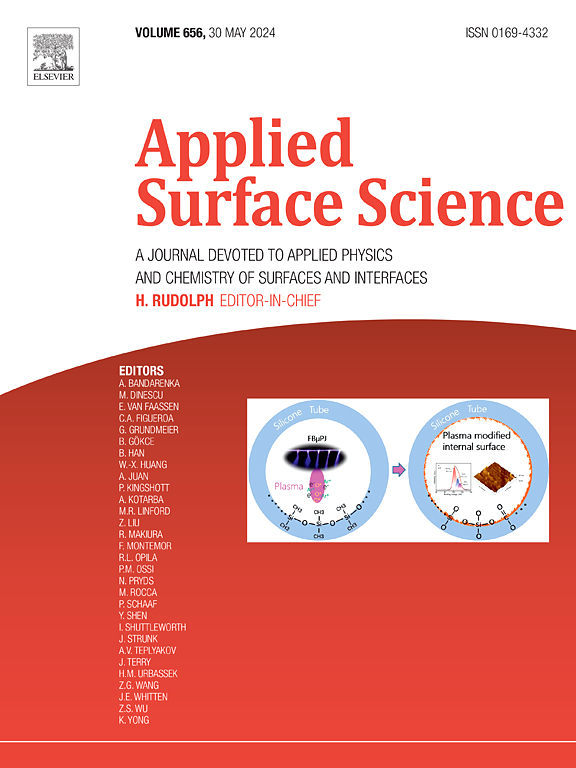采用等离子体增强原子层沉积法制备了一种新型过渡金属碳化物薄膜,用于Cu和Ru金属化的双扩散阻挡
IF 6.3
2区 材料科学
Q2 CHEMISTRY, PHYSICAL
引用次数: 0
摘要
与过渡金属氮化物(TMN)相比,过渡金属碳化物(TMC)通常在硬度、热稳定性、导电性和化学稳定性方面具有更优越的特性。然而,为这些材料开发原子层沉积(ALD)工艺仍处于早期阶段,尤其是碳化钇(YCx)薄膜,在很大程度上仍未得到开发。本研究的重点是开发一种等离子体增强 ALD-YCx 工艺,以获得高质量、均匀、保形的厚度控制 TMC,同时强调通过新型 Y 前驱体用作高级扩散屏障的先进性能。对关键实验工艺参数、Y-前驱体和 H2 等离子曝光时间进行了全面优化,以实现高导电性(∼415 μΩ-cm)、高结晶度 PEALD-Y2C 薄膜,在 ALD 温度窗口(150-350 °C)内,250 °C 时的生长速率为 ∼ 0.13 nm/周期。先进的像差校正电子显微镜、电子衍射和光谱技术证实形成了纳米晶斜方体相,C-Y 比为 0.46,密度为 4.63 g/cm3,沟槽结构具有良好的阶跃覆盖率(95%),长宽比为 1.5,底部宽度为 265 nm。退火后的 PEALD-Y2C 薄膜保持了稳定的热学和晶体学特性,在高达 900°C 的温度下对铜和 Ru(∼40 nm)表现出有效的双重扩散阻抗性能,突出了其在先进半导体器件互连中的重要性。本文章由计算机程序翻译,如有差异,请以英文原文为准。


Yttrium carbide thin film as an emerging transition metal carbide Prepared by plasma-enhanced atomic layer deposition for Dual diffusion barrier applications into Cu and Ru metallization
Transition metal carbides (TMCs) often possess superior properties to transition metal nitrides (TMNs) in hardness, thermal stability, electrical conductivity, and chemical stability. However, developing an atomic layer deposition (ALD) process for these materials remains in its early stages, especially yttrium carbide (YCx) thin films, which remained largely unexplored. This study focuses on developing a plasma-enhanced ALD-YCx process for high-quality, uniform, and conformal thickness control TMCs while highlighting the advanced properties to utilize as advanced diffusion barriers via a novel Y-precursor. The critical experimental process parameters, Y-precursor, and H2 plasma exposure times are thoroughly optimized to achieve highly conductive (∼415 μΩ·cm), high crystalline PEALD-Y2C thin films with a growth rate of ∼0.13 nm/cycle at 250 °C within the ALD temperature window (150–350 °C). Advanced aberration-corrected electron microscopies, electron diffractions, and spectroscopic techniques confirmed the formation of a nanocrystalline rhombohedral phase, C-to-Y ratio ∼0.46, 4.63 g/cm3 density, and excellent step coverage (95%) of a trench structure with an aspect ratio of ∼1.5 and a bottom width of ∼265 nm. The post-annealed PEALD-Y2C films maintained stable thermal and crystallographic properties, exhibiting effective dual diffusion barrier performance for Cu and Ru (∼40 nm) up to 900 °C, emphasizing its importance as interconnects in advanced semiconductor devices.
求助全文
通过发布文献求助,成功后即可免费获取论文全文。
去求助
来源期刊

Applied Surface Science
工程技术-材料科学:膜
CiteScore
12.50
自引率
7.50%
发文量
3393
审稿时长
67 days
期刊介绍:
Applied Surface Science covers topics contributing to a better understanding of surfaces, interfaces, nanostructures and their applications. The journal is concerned with scientific research on the atomic and molecular level of material properties determined with specific surface analytical techniques and/or computational methods, as well as the processing of such structures.
 求助内容:
求助内容: 应助结果提醒方式:
应助结果提醒方式:


